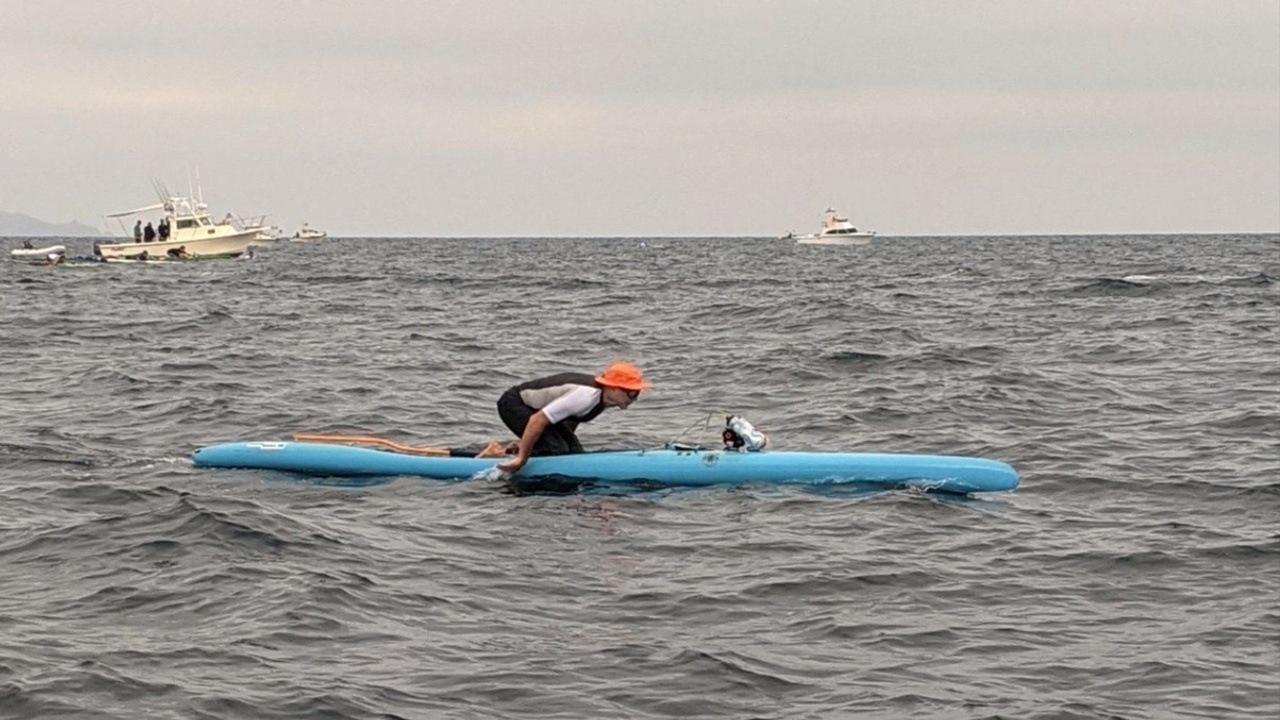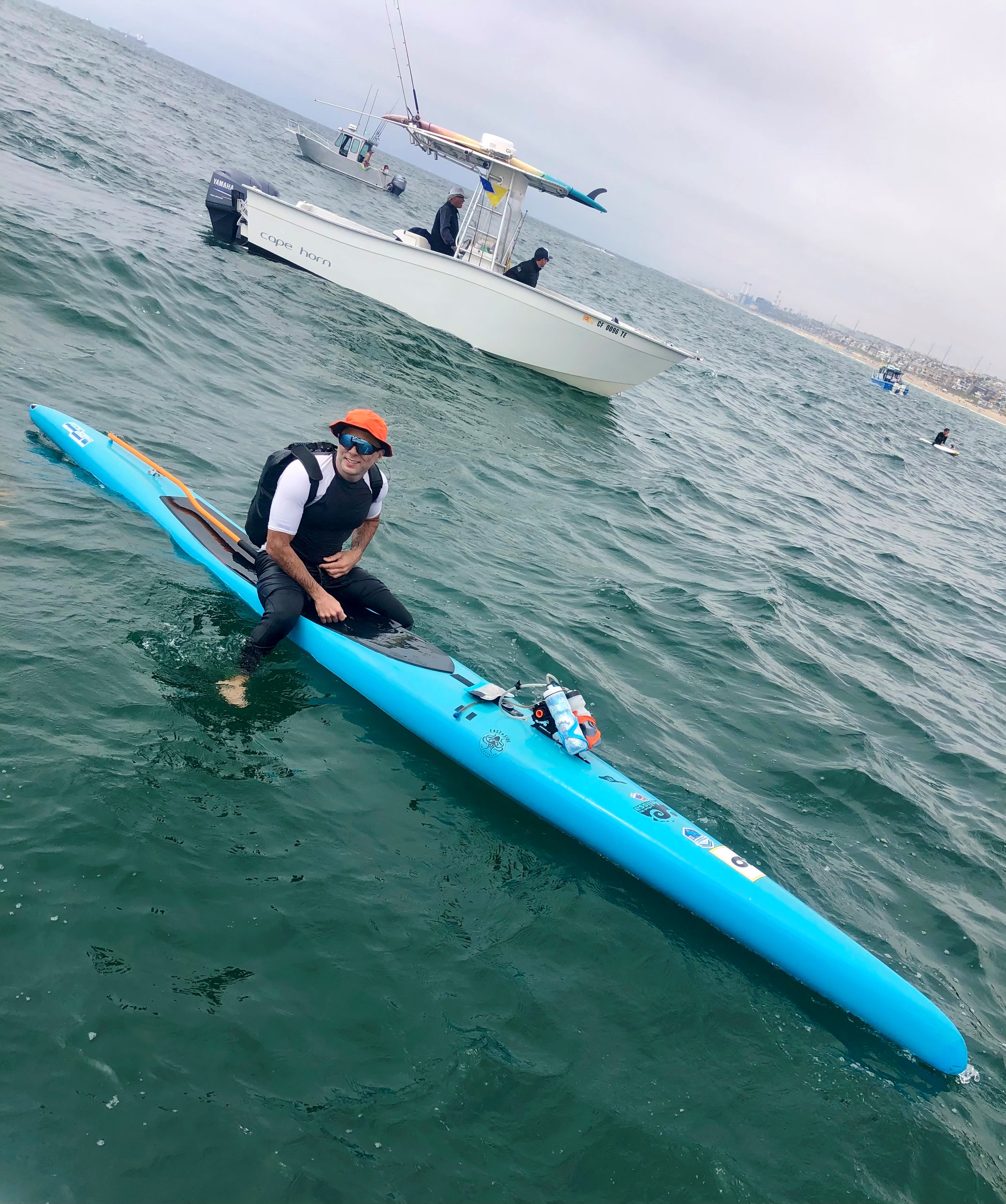32 Miles...And a Lot of Grit

photo: Sabine Dukes
One of our very own Surfing Paddling community members paddled the Catalina Classic (again) this month. And boy, was this year a tough one. That crossing is a difficult paddle even in the best of conditions, but this year’s race was particularly challenging.
Here is Brian’s story of perseverance and sheer grit from his own first-person account:
This August I had the great privilege to compete in my 3rd Catalina Classic 32 Mile Paddle Board Race (https://catalinaclassicpaddleboardrace.com/). This race has a long and storied history, dating back to Tom Blake and two others paddling from Palos Verdes to Catalina Island in 1932. The current form of the race started in 1955, lead by Bob Hogan, and would start on the isthmus (Two Harbors) on Catalina and end on the south side of the Manhattan Beach Pier. This year, 2021, saw the 44th edition of the race in this format.
After the race, I wrote up about 5 pages on this year's experience, but it was too long for an Instagram post. But here is the short version: it was incredibly arduous for me, and I think for everyone. Conditions were challenging, to say the least. Joe Bark has spent more time than almost anyone paddling this channel. He completed his 38th Catalina Classic this year and said it was perhaps the worst conditions start to finish he has experienced. DJ Wilson, a 13 time finisher, had similar sentiments. When paddlers with that experience say it was tough conditions then you know it was hard.
When I did the race in 2018 and 2019 we had good conditions overall - smooth seas for the first 2/3 of the race (wind comes up in the afternoon even on the best days) and favorable currents. I managed 6:20 in 2018 and 5:46 in 2019. Based on those two races, I anticipated finishing in around 6 hours, with similar conditions. The forecast looked a bit rough, so I thought maybe 7:00-7:30 was possible. I was about to learn that focusing on outcomes can prove to be a mistake.
 photo: Mike McDaniels
photo: Mike McDaniels
There had been WNW chop for a few days and a small south swell making for some mixed up seas as we went over to Catalina the day before the race. On race day we woke to winds blowing from the WNW all night and they only got stronger as the day went on. The race runs almost due north, so the wind and the windswell was predominately side on. As soon as we cleared the harbor and got out of the shelter of the island (about 1 mile) the chop was relentless. And it still had a touch of that south to add to the confused sea state. It was foggy and overcast, at least with a high ceiling, but that meant no sun, and no discernable horizon. About 10 miles in we hit an extremely strong current running against us. Needless to say, everyone was suffering. It was nearly impossible to knee paddle. Everyone had rashes from continually sliding around on their boards for 32 miles - chest, knees, feet. My board is not ideal in these conditions at all. It is meant for smooth conditions. My equipment definitely worked against me. Shorter boards (mine is 17’ 6”) and with more rocker to fit in the small chop had an advantage on this day.
For the first hour I was trying to settle in and realized times would be slow. I had a hard time finding a rhythm. Often I can find a rhythm with the chop, paddling harder down the backside of the little swells to take advantage of gravity and relaxing a bit going up. I just couldn’t find that rhythm. For the first 1/3 of the race one of my crew (11 time Catalina finisher, legendary Santa Cruz Paddler, and observant former chemistry teacher Phil Curtis) said my stroke looked good and efficient. That was really almost all the prone stroke, as I said, knee paddling was way too hard. Even when I could knee paddle, it was for just a few strokes to try and relieve some muscles, it was by no means efficient. In my perfect race plan I was going to spend ½-⅔ of the race knee paddling.
Around mile 14 things changed for the worse. I knew it as soon as it happened - I got seasick. I've had this experience in the past. When it happens, I lose all power. I couldn't stomach food or drink. So then it became a grind. I just focused on the next stroke, trying to make it be as good as possible - 45 degree entry, drive deep, etc. Count strokes... 4 strokes. 10 strokes. 8 strokes. 20 strokes. Focus on the next stroke, that is all you can control. It was a challenge, especially not being able to knee paddle to change up the muscles. I knew it would be a slow crawl to the finish and I just hoped to get there in the cut off time of 9 hours so I could requalify for next year. As you can imagine, not being able to take on food or drink, I lost a lot of energy towards the end and my muscles were protesting. I think I paddled only 3 mph the last 18 miles.
My boat crew, which included my wife, was incredible. They yelled encouragement, and had a positive attitude. The whole paddle I felt like I was letting them down, going so slowly the last 18 miles. But they didn’t see it that way, they saw it as a tremendous effort and fight to finish the race. With their support, I kept going, and eventually made it to the finish in 8:26. My result in terms of time and placing was not what I expected, but it was an important lesson to help me focus on things other than the outcomes. It was another opportunity to learn to be in the moment, not look to the future, not to dwell on the past.
It was a mental grind to get through that one. It brought up a lot of questions about why in the world am I doing all this training and putting myself through such an uncomfortable experience. I don’t have all the answers. I think it’s because I can. I know that sounds a bit odd. But really, that’s why. I’ve been fortunate to know a lot of amazing people whose lives were cut short by Cystic Fibrosis, Cancer, or drunk drivers. That has put some perspective on life, and made me realize we’ve got to try and do things that make us a bit uncomfortable, but also allow us to experience life and the range of emotions that come up pushing ourselves to do whatever it is we love to do. As Troy Nebeker says, go because you can.
At the end of the day I qualified for next year. Participating in Catalina is really an amazing experience. You’re part of a history of water people testing themselves in an ever changing environment. The community embraces all paddlers, and really does lift you up. This event allows you to be part of something much bigger than yourself. The stoke is real, even though it is a hard effort. The day after crossing that channel you are floating on air (well above water!). It is also about sharing the experience with fellow paddlers. At the moment, it is easy to feel isolated and alone out there. But when you get to the beach, you realize that other paddlers were struggling as much as you, some more. There is a bond formed when going through a challenging shared experience and it is something I think we humans need.
Immediately after the race I started planning for next year. I have taken steps to improve my equipment for rough seas and will work on the seasickness issues (mostly training with Dramamine/Bonine). I can’t wait to get back to the channel.
A couple of notes of appreciation: Thank you to my boat crew, they pulled me back in mentally when I would wander. Thank you to all the volunteers who make the Catalina Classic happen. It is a HUGE effort to pull that event off, involving many people on the island and on the mainland, in addition to coordinating with many different lifeguard agencies and the Coast Guard. Thanks to Mike McDaniels and Mile 22 for supporting the prone paddling community. And the reason I’m writing here, thank you so much to Rob for his help improving my paddle stroke. Another year of working on the technique improvements he’s helped me with and I’ll be paddling better than ever. If you’re on the fence about calling Rob for some input and evaluation, don’t wait. Your surfing and general paddling will improve with his guidance. I’ve noticed a bit more speed and a lot less fatigue using his techniques.

photo: Mike McDaniels
Thank you Brian for sharing your paddling story. And way to go! This is super inspirational!
Get Free Training, Quick Tips, News and Updates with the monthly newsletter!
Join our mailing list to receive the latest news and updates. Your information will not be shared.
